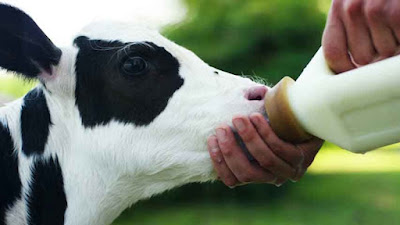Why is colostrum important for dairy calves?
Colostrum, the cow’s first milk, is critical to the health of the newborn calf and has a significant impact on the calf’s future performance. Calves are born lacking disease protection because antibodies (immunoglobulins) do not pass through the dam’s placenta to the fetal circulatory system. The critical immunoglobulins found in colostrum create passive immunity, providing calves with their initial protection against environmental pathogens and disease. Colostrum is also high in protein, fat and essential vitamins and helps calves begin to build a healthy immune system.
 |
| How much colostrum do dairy calves need? |
Why is timing critical for colostrum delivery?
A calf’s ability to absorb colostrum is at its highest within the first hour of life and begins to decline throughout the first 24 hours. This time is truly critical because a newborn calf’s digestive tract allows antibodies to pass directly into the blood. After this window closes, the calf’s intestines cannot absorb antibodies intact. Absorbed antibodies offer protection against systemic invasion by pathogens, while antibodies that are not absorbed play an essential role in protection against intestinal disease.
How much colostrum do dairy calves need?
Calves should receive one gallon (or at least 10% of their body weight) of colostrum within two hours (ideally, within 60 minutes) of their birth and two more quarts 12 hours later.
Why is colostrum management important?
Although colostrum significantly impacts the health of calves, the quality and quantity of this vital nutrient is entirely dependent on the dam, as well as farm management practices. Colostrum quality and quantity may be negatively impacted by:
The cow’s age: First-calf heifers generally produce smaller amounts of colostrum that is also typically lower-quality compared to the colostrum of more mature cows.
High stress: Stressed cows can leak colostrum prior to and/or during parturition, which decreases colostrum quantity.
Poor calving environments: Not having enough space or nutrients and/or an overly busy environment (e.g., too many other cows or staff coming in and out) can also contribute to lower colostrum quality.
Improper storage: When extra colostrum is available from a cow, save it, but be sure to chill or freeze it immediately to ensure that its optimum quality is preserved. Refrigerated colostrum should be stored no longer than two to three days before being fed in order to avoid potential contamination by harmful bacteria.
Inadequate nutrition: Appropriate protein levels are critical to colostrum quality and quantity. Feed additives have been proven to boost colostrum quality and quantity in peer-reviewed research.
A lack of cleanliness: Clean, high-quality colostrum can quickly become contaminated by bacteria and pathogens if handled improperly. Ensure that colostrum is properly collected from a clean udder, stored in a sanitized bucket or bottle and fed in a clean, sanitized bottle or esophageal tube feeder.
What are some benefits of feeding dairy calves quality colostrum?
- Increased profitability at weaning
- Improved lifetime performance
- Decreased illness and treatments
